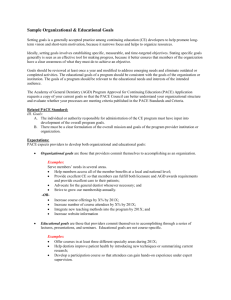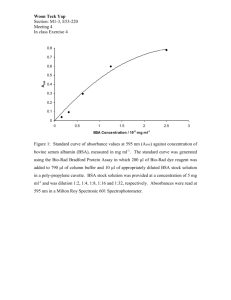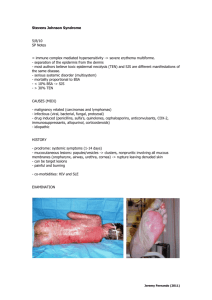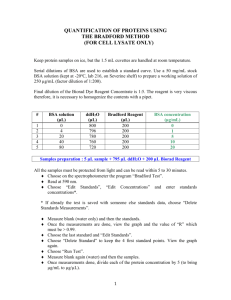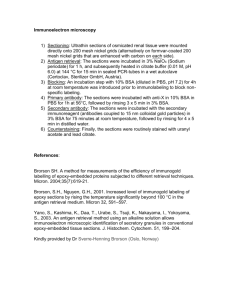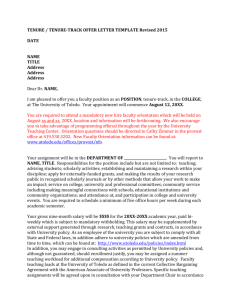European Commission
advertisement
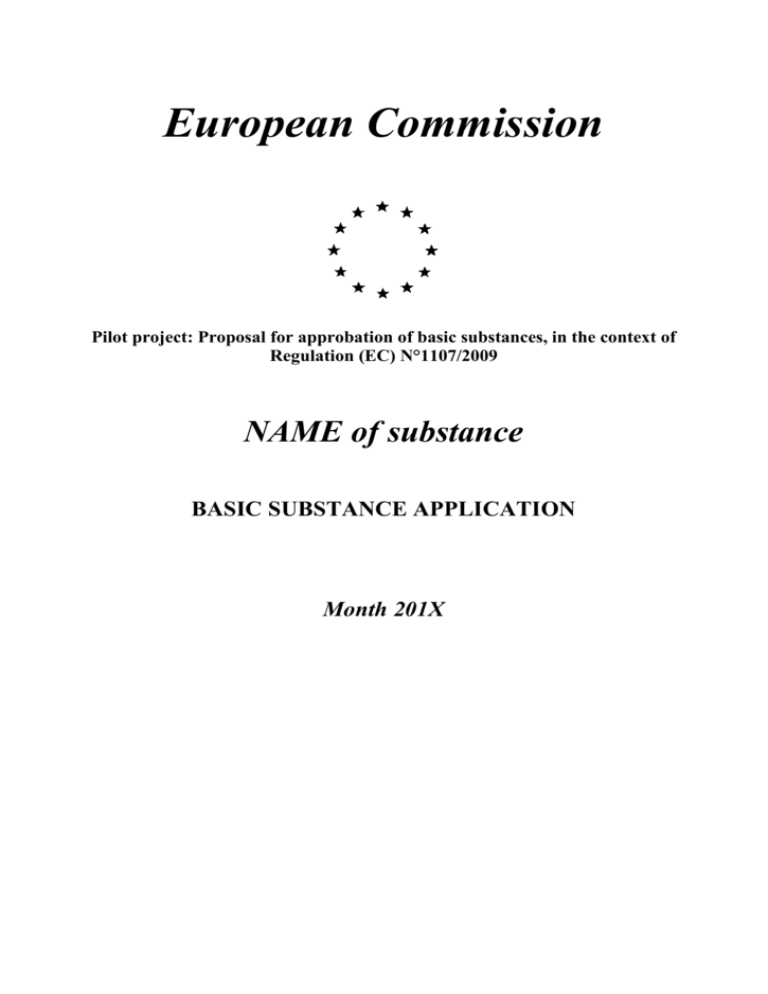
European Commission Pilot project: Proposal for approbation of basic substances, in the context of Regulation (EC) N°1107/2009 NAME of substance BASIC SUBSTANCE APPLICATION Month 201X BSA « Name of substance » month year 201X TABLE OF CONTENTS 1. PURPOSE OF THE APPLICATION ............................................................................................................. 4 1.1. NAME AND ADDRESS OF APPLICANTS .......................................................................................................... 4 2. IDENTITY OF THE SUBSTANCE/PRODUCT AS AVAILABLE ON THE MARKET AND PREDOMINANT USE ......................................................................................................................................... 5 2.1. IDENTITY AND PHYSICAL CHEMICAL PROPERTIES OF THE SUBSTANCE AND PRODUCT TO BE USED ......... 5 2.1.1. Common name of the substance and product and their synonyms/plant nomenclature ........................ 5 2.1.2. Chemical name with CAS, EEC and CIPAC numbers ......................................................................... 5 2.1.3. Molecular and structural formula, molecular mass ............................................................................... 5 2.1.4. Method or methods of manufacture of the substance and of the product .............................................. 5 2.1.5. Description and specification of purity of the active substance and product ........................................ 5 2.1.6. Identity of inactive isomers, impurities and additives ........................................................................... 5 2.1.7. Methods of analysis .............................................................................................................................. 5 2.2. CURRENT, FORMER AND IN CASE PROPOSED TRADE NAMES OF SUBSTANCES/ PRODUCTS AS PUT ON THE MARKET .............................................................................................................................................................. 5 2.3. MANUFACTURER OF THE SUBSTANCE/PRODUCTS ...................................................................................... 6 2.4. TYPE OF PREPARATION OF THE SUBSTANCE/PRODUCT .............................................................................. 6 2.5. DESCRIPTION OF THE RECIPE FOR THE PRODUCT TO BE USED .................................................................. 6 3. USES OF THE SUBSTANCE AND ITS PRODUCT .................................................................................... 6 3.1. FIELD OF USE ............................................................................................................................................... 6 3.2. EFFECTS ON HARMFUL ORGANISMS OR ON PLANTS (INCLUDING MODE OF ACTION) ................................ 6 3.2.1. Effects on harmful organisms ............................................................................................................... 6 3.2.2. Mode of action ...................................................................................................................................... 6 3.3. USEFULNESS IN THE FRAMEWORK OF PLANT PROTECTION ....................................................................... 6 3.4. SUMMARY OF INTENDED USES ..................................................................................................................... 7 4. CLASSIFICATION AND LABELLING OF THE SUBSTANCE ............................................................... 8 5. IMPACT ON HUMAN AND ANIMAL HEALTH ........................................................................................ 8 5.1. TOXICOKINETICS AND METABOLISM IN HUMANS ....................................................................................... 8 5.2. ACUTE TOXICITY ......................................................................................................................................... 8 5.3. SHORT-TERM TOXICITY .............................................................................................................................. 8 5.4. GENOTOXICITY ............................................................................................................................................ 8 5.5. LONG-TERM TOXICITY ................................................................................................................................ 8 5.6. REPRODUCTIVE TOXICITY........................................................................................................................... 8 5.7. NEUROTOXICITY.......................................................................................................................................... 8 BSA « Name of substance » month year 201X 5.8. TOXICITY STUDIES ON METABOLITES ......................................................................................................... 8 5.9. MEDICAL DATA: ADVERSE EFFECTS REPORTED IN HUMANS ...................................................................... 8 5.10. ADDITIONAL INFORMATION RELATED TO THERAPEUTIC PROPERTIES OR HEALTH CLAIMS .................. 8 5.11. ADDITIONAL INFORMATION RELATED TO USE AS FOOD ........................................................................... 9 5.12. ACCEPTABLE DAILY INTAKE, ACUTE REFERENCE DOSE, ACCEPTABLE OPERATOR EXPOSURE LEVEL ............................................................................................................................................................................ 9 5.13. IMPACT ON HUMAN AND ANIMAL HEALTH ARISING FROM EXPOSURE TO THE ACTIVE SUBSTANCE OR IMPURITIES CONTAINED IN IT............................................................................................................................. 9 6. RESIDUES......................................................................................................................................................... 9 7. FATE AND BEHAVIOUR IN THE ENVIRONMENT ................................................................................ 9 7.1. FATE AND BEHAVIOUR IN THE ENVIRONMENT............................................................................................ 9 7.2. ESTIMATION OF THE SHORT AND LONG-TERM EXPOSURE OF RELEVANT ENVIRONMENTAL MEDIA (SOIL, GROUND WATER, SURFACE WATER) ................................................................................................................... 9 8. EFFECTS ON NON-TARGET SPECIES ...................................................................................................... 9 8.1. EFFECTS ON TERRESTRIAL VERTEBRATES ................................................................................................. 9 8.1.1. Birds ...................................................................................................................................................... 9 8.1.2. Mammals............................................................................................................................................... 9 8.2. EFFECTS ON AQUATIC ORGANISMS ............................................................................................................. 9 8.3. EFFECTS ON BEES AND OTHER ARTHROPODS SPECIES ............................................................................... 9 8.3.1. Effects on bees ...................................................................................................................................... 9 8.3.2. Effects on other arthropods ................................................................................................................. 10 8.4. EFFECTS ON EARTHWORMS AND OTHER SOIL MACRO-ORGANISMS ........................................................ 10 8.5. EFFECTS ON SOIL MICRO-ORGANISMS ...................................................................................................... 10 8.6. EFFECTS ON OTHER NON-TARGET ORGANISMS (FLORA AND FAUNA) ...................................................... 10 8.7. EFFECTS ON BIOLOGICAL METHODS OF SEWAGE TREATMENT................................................................ 10 9. OVERALL CONCLUSIONS WITH RESPECT OF ELIGIBILITY OF THE SUBSTANCE TO BE APPROVED AS BASIC SUBSTANCE ............................................................................................................ 11 ANNEX I LIST REFERENCES RELIED ON ................................................................................................. 12 BSA « Name of substance » month year 201X "Name of substance" 1. PURPOSE OF THE APPLICATION This report is submitted to support the application for the approval of XXXXXXX as a basic substance according to Article 23 of Regulation (EC) No 1107/2009 of the European Parliament and Council. Include here reasons to support the substance as basic, its possible use in plant protection and when possible, information on its traditional use in agriculture e.g. interest for organic agriculture. 1.1. NAME AND ADDRESS OF APPLICANTS Name Contact person : Telephone : Fax : Email : Address Contact person : Telephone : Fax : Email : Address 4 BSA « Name of substance » month year 201X 2. IDENTITY OF THE SUBSTANCE/PRODUCT AS AVAILABLE ON THE MARKET AND PREDOMINANT USE Predominant uses of the substance outside plant protection Cite use fields and provide arguments why they shall be considered as predominant regarding the intended use in plant protection 2.1. IDENTITY AND PHYSICAL CHEMICAL PROPERTIES OF THE SUBSTANCE AND PRODUCT TO BE USED It can be the active substance itself or a simple diluent preparation. Description of the final product and method of preparation to be detailed under 2.5. 2.1.1. Common name of the substance and product and their synonyms/plant nomenclature Proposed name: xxxxxxxxxxx ISO common name (approved or proposed): Not applicable Synonyms: xx 2.1.2. Chemical name with CAS, EEC and CIPAC numbers 2.1.3. Molecular and structural formula, molecular mass 2.1.4. Method or methods of manufacture of the substance and of the product 2.1.5. Description and specification of purity of the active substance and product 2.1.6. Identity of inactive isomers, impurities and additives 2.1.7. Methods of analysis 2.1.7.1. Methods of analysis for determination of the active substance as manufactured 2.1.7.2. Analytical methods for determination of relevant impurities 2.1.7.3. Analytical methods for determination of residues 2.2. CURRENT, FORMER AND IN CASE PROPOSED TRADE NAMES OF SUBSTANCES/ PRODUCTS AS PUT ON THE MARKET Indicate some of the trade names under which the substance and products are normally marketed 5 BSA « Name of substance » month year 201X 2.3. MANUFACTURER OF THE SUBSTANCE/PRODUCTS Indicate the names of manufacturers when appropriate 2.4. TYPE OF PREPARATION OF THE SUBSTANCE/PRODUCT The substance/product should be described as well as how it is presented when placed on the market e.g. Dispersible concentrate (decoction) 2.5. DESCRIPTION OF THE RECIPE FOR THE PRODUCT TO BE USED Describe the recipe/dilution process in details. 3. USES OF THE SUBSTANCE AND ITS PRODUCT 3.1. FIELD OF USE 3.2. EFFECTS ON HARMFUL ORGANISMS OR ON PLANTS (INCLUDING MODE OF ACTION) 3.2.1. Effects on harmful organisms 3.2.2. Mode of action 3.3. USEFULNESS IN THE FRAMEWORK OF PLANT PROTECTION Indicate the mechanism of action against pests or any eliciting or barrier mechanism 6 BSA « Name of substance » month year 201X 3.4. SUMMARY OF INTENDED USES Crop and/or situation (a) Member State or Country Example product name as available on the market Formulation F G I (b) Application Pests or group of pests controlled (c) Type (d-f) Conc of a.i. g/kg (i) Method kind (f-h) Growth stage and season (j) Number min max (k) Interval between applications (min) Application rate per treatment kg kg Water a.i./ha a.i./hl l/ha min min min max max max (g/ha) (g/hl) (l) * e.g. The product can used for post-harvest application) * (a) (b) (c) (d) (e) (f) (g) (h) For uses where the column „Remarks. As above or other conditions to take into account For crops, the EU and Codex classification (both) should be taken into account ; where relevant, the use situation should be described (e.g. fumigation of a structure) Outdoor or field use (F), greenhouse application (G) or indoor application (I) e.g. pests as biting and suckling insects, soil born insects, foliar fungi, weeds or plant elicitor e.g. wettable powder (WP), emulsifiable concentrate (EC), granule (GR) etc.. GCPF Codes – GIFAP Technical Monograph N° 2, 1989 All abbreviations used must be explained Method, e.g. high volume spraying, low volume spraying, spreading, dusting, drench Kind, e.g. overall, broadcast, aerial spraying, row, individual plant, between the plant – type of equipment used must be indicated (i) g/kg or g/L. Normally the rate should be given for the active substance (according to ISO) (j) Growth stage at last treatment (BBCH Monograph, Growth Stages of Plants, 1997, Blackwell, ISBN 3-8263-3152-4), including where relevant, information on season at time of application (k) Indicate the minimum and maximum number of application possible under practical conditions of use (l) The values should be given in g or kg whatever gives the more manageable number (e.g. 200 kg/ha instead of 200 000 g/ha or 12.5 g/ha instead of 0.0125 kg/ha (m) PHI - minimum pre-harvest interval 7 Total rate kg a.i./ha min max (g/ha) (l) PHI (days) (m) Remarks (*,**) BSA « Name of substance » month year 201X 4. CLASSIFICATION AND LABELLING OF THE SUBSTANCE When not applicable as justified by ………. 5. IMPACT ON HUMAN AND ANIMAL HEALTH Effects having relevance to human and animal health arising from exposure to the substance/its products or to impurities contained in the substance/product or their transformation products 5.1. TOXICOKINETICS AND METABOLISM IN HUMANS 5.2. ACUTE TOXICITY 5.3. SHORT-TERM TOXICITY 5.4. GENOTOXICITY 5.5. LONG-TERM TOXICITY 5.6. REPRODUCTIVE TOXICITY 5.7. NEUROTOXICITY 5.8. TOXICITY STUDIES ON METABOLITES 5.9. MEDICAL DATA: ADVERSE EFFECTS REPORTED IN HUMANS 5.10. ADDITIONAL INFORMATION RELATED TO THERAPEUTIC PROPERTIES OR HEALTH CLAIMS 8 BSA « Name of substance » month year 201X 5.11. ADDITIONAL INFORMATION RELATED TO USE AS FOOD 5.12. ACCEPTABLE DAILY INTAKE, ACUTE REFERENCE DOSE, ACCEPTABLE OPERATOR EXPOSURE LEVEL 5.13. IMPACT ON HUMAN AND ANIMAL HEALTH ARISING FROM EXPOSURE TO THE ACTIVE SUBSTANCE OR IMPURITIES CONTAINED IN IT 6. RESIDUES 7. FATE AND BEHAVIOUR IN THE ENVIRONMENT 7.1. FATE AND BEHAVIOUR IN THE ENVIRONMENT 7.2. ESTIMATION OF THE SHORT AND LONG-TERM EXPOSURE OF RELEVANT ENVIRONMENTAL MEDIA (SOIL, GROUND WATER, SURFACE WATER) 8. EFFECTS ON NON-TARGET SPECIES Effects having relevance to non-target organisms arising from exposure to the substance/its products or to impurities contained in the substance/product or their transformation products 8.1. EFFECTS ON TERRESTRIAL VERTEBRATES 8.1.1. Birds 8.1.2. Mammals 8.2. EFFECTS ON AQUATIC ORGANISMS 8.3. EFFECTS ON BEES AND OTHER ARTHROPODS SPECIES 8.3.1. Effects on bees 9 BSA « Name of substance » month year 201X 8.3.2. Effects on other arthropods 8.4. EFFECTS ON EARTHWORMS AND OTHER SOIL MACRO-ORGANISMS 8.5. EFFECTS ON SOIL MICRO-ORGANISMS 8.6. EFFECTS ON OTHER NON-TARGET ORGANISMS (FLORA AND FAUNA) 8.7. EFFECTS ON BIOLOGICAL METHODS OF SEWAGE TREATMENT 10 BSA « Name of substance » month year 201X 9. OVERALL CONCLUSIONS WITH RESPECT OF ELIGIBILITY OF THE SUBSTANCE TO BE APPROVED AS BASIC SUBSTANCE It has to be described in synthesis the fulfilment of the following criteria to allow for the identification as basic substance (a) is not a substance of concern; and (b) does not have an inherent capacity to cause endocrine disrupting, neurotoxic or immunotoxic effects; and (c) is not predominantly used for plant protection purposes but nevertheless is useful in plant protection either directly or in a product consisting of the substance and a simple diluent; and (d) is not placed on the market as a plant protection product. It should be also included a synthesis of the conclusions of the evaluation demonstrating that the substance has neither an immediate or delayed harmful effect on human or animal health nor an unacceptable effect on the environment and therefore could be approved as "basic substance". 11 BSA « Name of substance » month year 201X ANNEX I LIST REFERENCES RELIED ON Include here all references studies and assessment reports cited in the various chapter of application model. Title Source Author(s) Year Company, report N° GLP or GEP status Published or not SECTION 1: Purpose of the application Title: Source: Title Source Author(s) Year Company, report N° GLP or GEP status Published or not SECTION 2: Identity of the substance/product as available on the market and predominant use Title: Source: Title Source Author(s) Year Company, report N° GLP or GEP status Published or not SECTION 3 : Uses of the substance and its product Title: Source: Title Source Author(s) Year Company, report N° GLP or GEP status Published or not SECTION 4: Classification and labelling of the substance Title: Source: Title Source Author(s) Year Company, report N° GLP or GEP status Published or not SECTION 5 : Impact on human and animal health Title: Source: Author(s) Year Title Source Company, report N° 12 BSA « Name of substance » month year 201X GLP or GEP status Published or not SECTION 6 : Residues Title: Source: Title Source Author(s) Year Company, report N° GLP or GEP status Published or not SECTION 7 : Fate and Behaviour in the environment Title: Source: Title Source Author(s) Year Company, report N° GLP or GEP status Published or not SECTION 8 : Effects on non-target species Title: Source: 13
